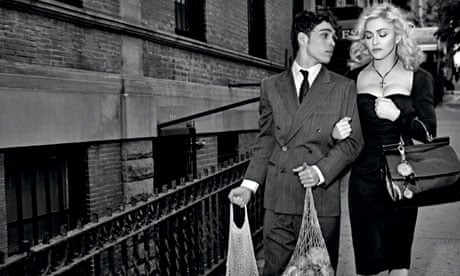As a woman you reach a certain age where you start to become invisible. It's an odd sensation, as if someone has thrown a Potterish invisibility cloak over you. It's a sort of inversion of the old joke of sticking a Post-it note with a daft message to your back, the joke now being that people on the street look straight through you. It has little to do with aesthetics; it's more chemical than that. It is just that women, more than men, occupy space in the world's consciousness in correlation with youth. (I can pinpoint exactly when it happened to me: I was 34. But that's just me; my life has always been weirdly date-specific. I grew up when I was 28.)
But, what's this? In the space of the last year, a curious thing has happened. Older women have become increasingly visible in the arena in which, above all others, nubile youth has long trumped all else: fashion. Of all the spheres of influence in which youth and beauty could be relied upon to rule with an iron grip, fashion has long been the most ruthless. (Best ever fashion-world horror story for pure terrifying evilness – I'm assuming it's apocryphal – is about the parties held by Rachel Zoe's mini-me starlets in LA at the height of the size-zero obsession, where the guest list consisted of a pair of weighing scales at the door, and no girls weighing more than 100lbs were allowed in.) Yet next season's Dolce & Gabbana advertising campaign, unveiled last week, stars Madonna (51). Hot label of the moment Celine – the campaign every model must have wanted this season – has chosen a veteran face from the 1990s superwaif era, Emma Balfour (40). Balenciaga stars Stella Tennant (39); Louis Vuitton, whose new collection was dubbed "And God Created Woman" by designer Marc Jacobs, featured Elle Macpherson (47) on the catwalk and stars Christy Turlington (41) in its latest print campaign. Glossy magazines at both ends of the style spectrum have chosen older models for their latest issues: Macpherson is on the cover of the new Tatler, while Dazed features Kristen McMenamy (46) as the newstand face of an issue dedicated to "iconic models" on sale tomorrow.
Inez van Lamsweerde and Vinoodh Matadin are a Dutch photographic duo who have been working together for two decades. They recently shot a new campaign for Yves Saint Laurent starring 26-year-old Daria Werbowy. Until not long ago, 26 was very much past one's prime, as a model, but Lamsweerde and Matadin recently told vogue.com that "models like Kate [Moss] and Daria are mature, they've grown up, they're women who have had a life and experience. For about five or six years now we haven't shot anyone under 18 for that reason, but also for the fact that, we feel the modelling business should not promote girls working under this age. They're not out of school – their bodies haven't developed yet and they don't have a sense of self. Sometimes they haven't had sex yet. It's hard to project all these things on someone who hasn't had that experience."
Such common sense is completely revolutionary. Until recently, few in the industry would acknowledge that there was something a teensy bit shallow and moronic and possibly even dubious about taking a 16-year-old model with a head full of Justin Bieber daydreams and GCSE revision notes and dressing her up as a sophisticated femme fatale, arranging her supine on an unmade hotel bed, while dripping with diamond bracelets and thousand-pound handbags and wearing a bored-of-it-all expression. Extreme youth was part and parcel of the fantasy of fashion.
The new visibility of older models is part of a shift in fashion from fantasy to wearability. For the past 10 years, one adjective has reigned supreme above others in fashion. If it was good – whether it was a model, a dress, a handbag, a cocktail – it was "fabulous". Fabulous, in the Oxford English Dictionary, has two meanings: extraordinary, and also "having no basis in reality; mythical". Our obsession with fabulousness was always very much about a yearning for the impossible, a boomtime obsession with pushing boundaries. The word feels, now, like a compliment from another era.
The age of austerity dawned in fashion months before George Osborne got his hands on the keys to No 11. In March, the Paris catwalks were full of grown-up clothes in sensible, wearable colours. Even before the bloodbath budget, fashion had a new buzzword to replace fabulousness – "believability". Easy-to-do ponytails and walkable-heeled shoes are hot topics in fashion right now. The issue of whether the women who can afford these clothes can also wear them without looking absurd is deemed relevant again.
Francisco Costa, designer of Calvin Klein, cast Kristen McMenamy and Stella Tennant for his most recent catwalk show in New York. "I wanted a cast that really represented a customer I design for, and that's not really a 16-year-old," he said after the show. "The woman who puts my clothes on needs a certain level of sophistication. We wanted to acknowledge the women who have always worn our clothes: women who have their own identities, have full lives, have kids."
Next month, the all-important September issues of the glossy magazines appear. Current industry rumour has it that the cover girls for the American giants run as follows: Julia Roberts for Elle, Halle Berry for Vogue, and Jennifer Aniston for Harpers Bazaar. If this is true, Aniston – at 41 – will be the youngest cover girl of the big three. If older women can reappear in fashion, then anything is possible. There may even be hope in Hollywood.






Comments (…)
Sign in or create your Guardian account to join the discussion